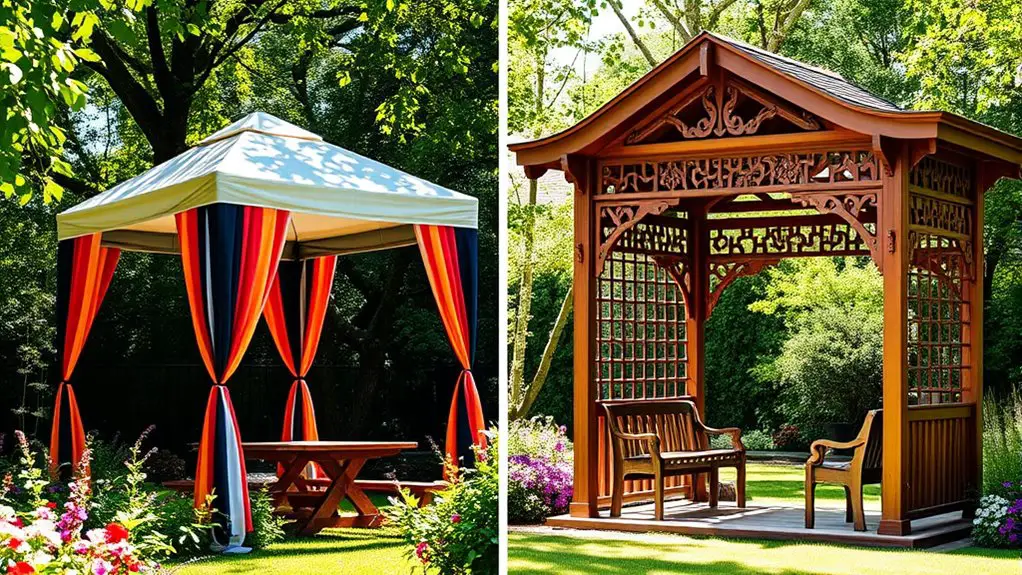When considering pop-up gazebos versus traditional gazebos, you’ll find each has its own pros and cons. Pop-up gazebos offer quick, tool-free setup and portability, perfect for outdoor gatherings. However, they might struggle with stability and durability in harsh weather. Traditional gazebos provide aesthetic appeal and robust construction, although they require more time and investment to install and maintain. It’s important to assess your specific needs and circumstances to determine which option suits you best. More insights await you on this topic.
Overview of Pop-up Gazebos
When you consider outdoor gatherings, pop-up gazebos offer a versatile option that’s both practical and convenient. Their design features typically include a lightweight frame made of durable materials, allowing for easy setup and takedown. Many models boast weather-resistant canopies, ensuring protection from sun and rain. Portability options are another significant advantage; most pop-up gazebos come with carrying bags, making them easy to transport to various locations. Depending on your needs, you can find sizes that accommodate small gatherings or larger events. The quick assembly process means you won’t waste time, giving you more freedom to enjoy your outdoor experience. Altogether, pop-up gazebos serve as functional solutions for those looking to enhance their outdoor settings. Additionally, many models, such as the Gazelle Tents 21500 G6, provide comprehensive insect protection with their tight weave mesh walls.
Advantages of Pop-up Gazebos
While traditional gazebos have their charm, pop-up gazebos present a range of advantages that make them ideal for modern outdoor activities. You’ll find their portability benefits particularly appealing, as they’re lightweight and easy to transport. The setup convenience is another highlight; it typically takes just minutes to have your structure ready. Here are some key advantages:
- Quick Assembly: No tools required—just unfold and secure.
- Versatile Use: Perfect for picnics, parties, or camping trips.
- Compact Storage: Fits easily in your car or closet when not in use.
- Affordable Options: Budget-friendly choices available without compromising quality.
Additionally, pop-up gazebos often come with adjustable legs for stability to ensure a secure setup on uneven ground. With these advantages, pop-up gazebos cater to your need for flexibility and spontaneity in outdoor living.
Disadvantages of Pop-up Gazebos
Although pop-up gazebos offer remarkable convenience, they come with a set of disadvantages that potential buyers should consider. One of the primary concerns is stability issues, particularly in windy conditions. These structures can easily tip over if not anchored properly. Additionally, many users experience setup difficulty, as some models require more effort than anticipated.
Here’s a comparison of key disadvantages:
| Disadvantage | Description |
|---|---|
| Stability Issues | Vulnerable to wind and tipping |
| Setup Difficulty | Some models require complex assembly |
| Durability | Often less sturdy than traditional |
| Size Limitations | Limited space compared to built gazebos |
| Aesthetic Appeal | Less visually appealing for some |
Proper anchoring methods are crucial for stability, especially in windy conditions. Understanding these drawbacks is essential for making an informed choice that aligns with your needs.
Overview of Traditional Gazebos
Traditional gazebos stand as timeless structures that enhance outdoor spaces with both functionality and beauty. These permanent fixtures often serve as gathering spots, providing shelter and a focal point in gardens or parks. They come with various design features that can complement your landscape while offering practical benefits.
Consider these key aspects:
- Design Features: From octagonal to rectangular shapes, you can find styles that suit your aesthetic.
- Material Options: Wood, metal, and vinyl are popular choices, each offering unique advantages.
- Customization: You can personalize with railings, screens, or decorative elements.
- Durability: Built to withstand elements, traditional gazebos promise longevity. They are often designed with essential features that enhance comfort and usability.
With their enduring charm, traditional gazebos offer a versatile solution for outdoor enjoyment.
Advantages and Disadvantages of Traditional Gazebos
When considering the purchase of a gazebo, it is essential to weigh both the advantages and disadvantages of traditional models. One major advantage is their superior design aesthetics; these gazebos often enhance the beauty of your outdoor space, serving as a stunning focal point. They’re typically built from durable materials, ensuring longevity. However, with durability comes increased maintenance requirements. You’ll need to regularly check for rotting wood, rusting metal, and weather damage, which can be time-consuming. Additionally, traditional gazebos often require a more significant investment of time and money for installation compared to pop-up alternatives. Furthermore, investing in a traditional gazebo can increase property value and attract potential buyers due to its aesthetic appeal. Ultimately, while traditional gazebos offer elegance and permanence, they demand a commitment to upkeep that might not suit everyone’s lifestyle.
Frequently Asked Questions
How Long Does It Take to Set up a Pop-Up Gazebo?
When it comes to setup time, you can hit the ground running with a pop-up gazebo. Generally, it takes about 10-15 minutes. For smooth installation, follow these tips: practice, guarantee all parts are in place.
Can Traditional Gazebos Be Moved After Installation?
Yes, traditional gazebos can be moved, but you’ll face installation challenges. Relocation options depend on the structure’s foundation and materials. You might need professional help to guarantee it’s safely and properly repositioned for your freedom.
What Materials Are Used in Pop-Up Gazebos?
Imagine setting up a shelter in moments. Pop-up gazebos typically feature lightweight aluminum frames and durable fabric canopies, providing flexibility and ease. These materials allow for quick assembly, perfect for spontaneous outdoor gatherings or adventures.
Are Pop-Up Gazebos Waterproof?
Yes, many pop-up gazebos have waterproof features, offering varying degrees of weather resistance. When selecting one, check the material specifications and seams to verify it meets your needs for protection against the elements.
How Do I Maintain a Traditional Gazebo?
Imagine your traditional gazebo standing tall like a sentinel. For maintenance, regularly inspect for damage, clean surfaces with mild soap, and apply protective sealants. These gazebo cleaning tips guarantee its beauty endures, granting you endless moments of freedom.

